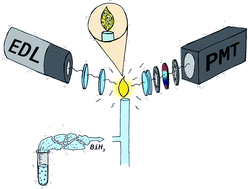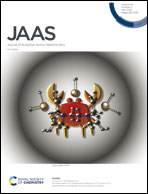Atomic fluorescence spectrometry for ultrasensitive determination of bismuth based on hydride generation – the role of excitation source, interference filter and flame atomizers†
Abstract
A method of highly sensitive bismuth determination by hydride generation coupled with in-house assembled non-dispersive atomic fluorescence spectrometry was developed. Bismuthane was generated by the reaction with NaBH4 in HCl medium in a flow injection arrangement and directed by a stream of carrier gas and hydrogen to an atomizer. A detailed optimization of the optical path of the spectrometer (electrodeless discharge lamp, lenses and interference filter) and atomization parameters in two flame atomizers – miniature diffusion flame and flame-in-gas-shield atomizer – was performed. An excellent repeatability below 1% and extremely low limits of detection were achieved, namely 1.8 ng L−1 with the miniature diffusion flame atomizer and 0.9 ng L−1 with the flame-in-gas-shield atomizer and 307.1 nm interference filter. Interferences of other hydride forming elements were investigated. The developed ultrasensitive methodology was successfully verified by Bi determination in certified reference materials of (sea)water and of hair and blood after microwave assisted digestion.



 Please wait while we load your content...
Please wait while we load your content...